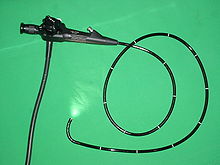Autoimmune polyendocrine syndrome type 1
| Autoimmune polyendocrine syndrome type 1 | |
|---|---|
| Other names | Autoimmune polyendocrinopathy-candidiasis–ectodermal dystrophy/dysplasia (APECED),
Autoimmune polyglandular syndrome type 1, Whitaker syndrome, Candidiasis-hypoparathyroidism–Addison's disease syndrome |
 | |
| Autoimmune polyendocrine syndrome type 1 is autosomal recessive | |
| Specialty | Endocrinology, medical genetics |
| Symptoms | chronic mucocutaneous candidiasis |
| Causes | mutation in AIRE gene |
| Diagnostic method | CT scan, biopsy |
| Treatment | hormone therapy, antifungals, immunosuppression |
Autoimmune polyendocrine syndrome type 1 (APS-1), is a subtype of autoimmune polyendocrine syndrome (autoimmune polyglandular syndrome). It causes the dysfunction of multiple endocrine glands due to autoimmunity. It is a genetic disorder, inherited in autosomal recessive fashion due to a defect in the AIRE gene (autoimmune regulator), which is located on chromosome 21 and normally confers immune tolerance.[1][2][3]
Signs and symptoms
APS-1 tends to cause severe symptoms.[4] These are present from early in life, usually around 3.5 years of age.[4] Common symptoms of APS-1 include:
- Chronic mucocutaneous candidiasis.[4]
- Hypoparathyroidism.[4]
- Addison's disease.[4]
- Ectodermal dystrophy (skin, dental enamel, and nails).
APS-1 may also cause:
- Autoimmune hepatitis.[4]
- Hypogonadism.[4]
- Vitiligo.[4]
- Alopecia.[4]
- Malabsorption.
- Pernicious anemia.
- Cataract.
- Cerebellar ataxia.[5]
Cause

APS-1 is caused by a mutation in the AIRE gene, encoding a protein called autoimmune regulator. This is found on the 21q22.3 chromosome location, hence chromosome 21.[1][2][6] The AIRE gene may be affected by any of at least 90 mutations.[medical citation needed] Mutations may be inherited in an autosomal recessive manner.
Different mutations are more common in different geographic regions. R139X is a common mutation in Sardinia.[4] R257* is a common mutation in Finland.[5]
Pathophysiology
APS-1 is due to problems with immune tolerance.[7] APS-1 causes considerable reactions with both interferon omega and interferon alpha.[4][8] There may also be a reaction against interleukin 22.[4] This leads to damage to endocrine organs.[4] Common problems include hypercalcaemia and nephrocalcinosis (due to a lack of calcitonin from the thyroid), and pituitary problems (such as growth hormone deficiency).[4] Antibodies against NLRP5 may lead to hypoparathyroidism.[citation needed]
Diagnosis

Diagnosis of APS-1 is based on a number of tests, including endoscopy, a CT scan,[8] a biopsy (with histological testing),[8] and serum endocrine autoantibody screening.
Treatment
Autoimmune polyendocrine syndrome type 1 treatment is based on the symptoms that are presented by the affected individual. Treatments may involve hormone therapy,[9] systemic antifungal treatments,[4][9] and immunosuppression.[9]
History
APS-1 may also be known as autoimmunity endocrinopathy candidiasis ectodermal dystrophy / dysplasia (APECED),[citation needed] autoimmune polyglandular syndrome type 1,[citation needed] Whitaker syndrome,[8] or candidiasis-hypoparathyroidism-Addison's disease syndrome.[10]
See also
References
- ^ a b "AIRE gene". Genetics Home Reference. Retrieved 2017-04-04.
- ^ a b "APECED". Retrieved 2017-04-04.
- ^ Shoenfeld Y, Cervera R, Gershwin ME (2010-06-08). Diagnostic Criteria in Autoimmune Diseases. Springer Science & Business Media. p. 265. ISBN 9781603272858.
- ^ a b c d e f g h i j k l m n o Meloni, Antonella; Willcox, Nick; Meager, Anthony; Atzeni, Michela; Wolff, Anette S. B.; Husebye, Eystein S.; Furcas, Maria; Rosatelli, Maria Cristina; Cao, Antonio; Congia, Mauro (April 2012). "Autoimmune Polyendocrine Syndrome Type 1: An Extensive Longitudinal Study in Sardinian Patients". The Journal of Clinical Endocrinology & Metabolism. 97 (4): 1114–1124. doi:10.1210/jc.2011-2461. ISSN 0021-972X. PMID 22344197.
- ^ a b Orlova, Elizaveta M; Sozaeva, Leila S; Kareva, Maria A; Oftedal, Bergithe E; Wolff, Anette S B; Breivik, Lars; Zakharova, Ekaterina Y; Ivanova, Olga N; Kämpe, Olle; Dedov, Ivan I; Knappskog, Per M (2017-07-20). "Expanding the Phenotypic and Genotypic Landscape of Autoimmune Polyendocrine Syndrome Type 1". The Journal of Clinical Endocrinology & Metabolism. 102 (9): 3546–3556. doi:10.1210/jc.2017-00139. ISSN 0021-972X. PMID 28911151. S2CID 3822560.
- ^ "Autoimmune Polyglandular Syndrome Type 1 (APS-1)". NIH: National Institute of Allergy and Infectious Diseases. Retrieved 2017-04-16.
- ^ De Martino L, Capalbo D, Improda N, D'Elia F, Di Mase R, D'Assante R, et al. (October 2013). "APECED: A Paradigm of Complex Interactions between Genetic Background and Susceptibility Factors". Frontiers in Immunology. 4: 331. doi:10.3389/fimmu.2013.00331. PMC 3805967. PMID 24167503.
- ^ a b c d Aldasouqi, Saleh A. (15 November 2016). "Type I Polyglandular Autoimmune Syndrome". emedicine.medscape.com. Medscape. Archived from the original on 2008-12-09. Retrieved 20 November 2020.
- ^ a b c INSERM RESERVED. "Orphanet: Autoimmune polyendocrinopathy type 1". www.orpha.net. Retrieved 2017-04-22.
- ^ Greenspan, F. S.; Gardner, D. C. (2004). Basic clinical endocrinology. New York: McGraw-Hill. pp. 103. ISBN 978-0-07-140297-2.
Further reading
- De Martino L, Capalbo D, Improda N, Lorello P, Ungaro C, Di Mase R, et al. (1 January 2016). "Novel Findings into AIRE Genetics and Functioning: Clinical Implications". Frontiers in Pediatrics. 4: 86. doi:10.3389/fped.2016.00086. PMC 4992815. PMID 27597936.
- Peterson P, Pitkänen J, Sillanpää N, Krohn K (March 2004). "Autoimmune polyendocrinopathy candidiasis ectodermal dystrophy (APECED): a model disease to study molecular aspects of endocrine autoimmunity". Clinical and Experimental Immunology. 135 (3): 348–57. doi:10.1111/j.1365-2249.2004.02384.x. PMC 1808970. PMID 15008965.
- Capalbo D, De Martino L, Giardino G, Di Mase R, Di Donato I, Parenti G, et al. (2012). "Autoimmune polyendocrinopathy candidiasis ectodermal dystrophy: insights into genotype-phenotype correlation". International Journal of Endocrinology. 2012: 353250. doi:10.1155/2012/353250. PMC 3485503. PMID 23133448.
